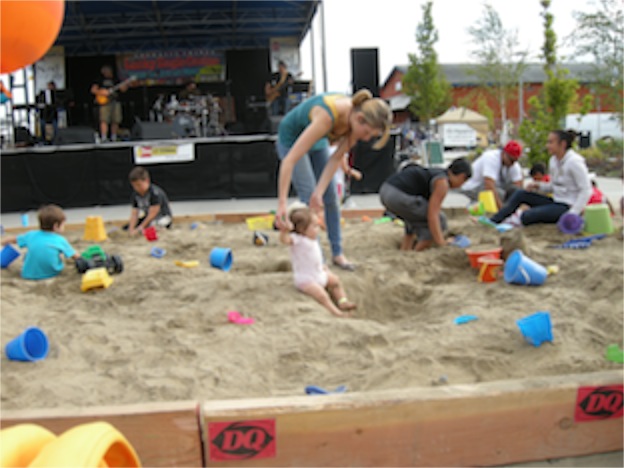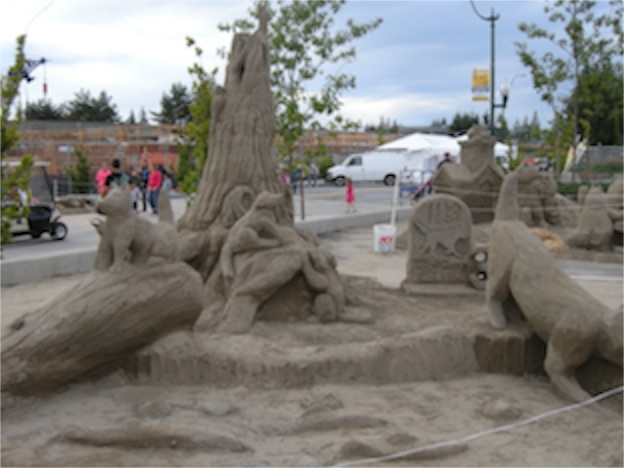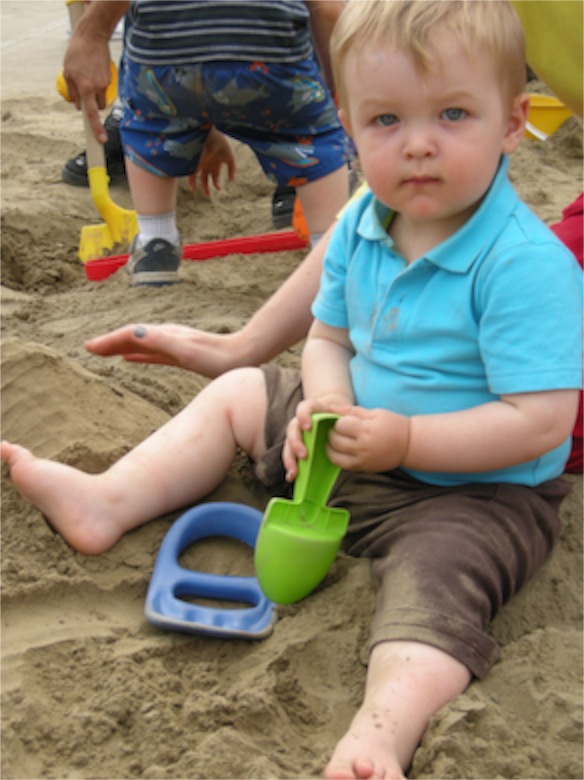Sand
27/08/12 05:05
Back home in Rapid City we have a stock show each year. The event, held in the winter, is a huge gathering of farmers and ranchers and the people who sell supplies to them. There are auctions of prize animals, displays of farm machinery, and booths with vendors selling everything from clothing to veterinary supplies. There are sheep dog trials and horse shows and, of course, rodeos. The rodeos fill the arena in every way imaginable: a full crowd in the seats, full sound on the p.a. system, an arena full of animals and action, and one heck of a lot of dirt on the floor. It takes dump trucks and heavy equipment to haul in and spread all of the dirt that is necessary to transform an indoor arena into a rodeo ground. Most years someone at the newspaper writes an article illustrated with pictures about the process of hauling in all of the dirt that is required to transform the indoor venue into a rodeo grounds.
 It was a similar-sized effort that went into creating the Olympia Sand Festival that concluded yesterday. They hauled in a lot of sand to transform a city street into a giant sand box. There were rows of giant sand sculptures, each requiring several yards of sand. Like the dirt that is spread in the arena in Rapid City, the sand doesn’t have to travel far. The Puget Sound is a huge depository of sand. There are sandy beaches, dunes of sand, and lots of places that are now inland that once were under water.
It was a similar-sized effort that went into creating the Olympia Sand Festival that concluded yesterday. They hauled in a lot of sand to transform a city street into a giant sand box. There were rows of giant sand sculptures, each requiring several yards of sand. Like the dirt that is spread in the arena in Rapid City, the sand doesn’t have to travel far. The Puget Sound is a huge depository of sand. There are sandy beaches, dunes of sand, and lots of places that are now inland that once were under water.
Still, the efforts of the planners and workers were impressive. There was a stage set up in an intersection of closed-off streets and in front of the stage, huge cedar beams were laid in the street to allow about 20 yards of sand to be spread a foot to 18 inches deep. Then they added a whole lot of sand toys: plastic shovels and buckets and rakes and forms for making castles. The sand box was a giant kid magnet, attracting children from throughout the region to dig, shape, and play in the sand. They made castles and roads and dug holes and buried their feet and hands in the sand. They laid back and made sand angels and rolled in the sand.
Meanwhile, teams of adults from area businesses were forming huge sculptures for the sand sculpture competition.
There was a traditional petting zoo with chickens and sheep and goats and other familiar animals. There was also a wet petting zoo with saltwater tanks where children could touch sea stars and crabs and mussels and clams and a host of other sea creatures. There were vendors selling food and clothing and, of course, sand toys.
It was a festival worthy of a creative city and a delight to visit.
A sand box is a wonderful place for an eighteen-month-old child to play. And it is a great place for grandparents to take pictures. There was music and the weather cooperated wonderfully. Washington is a good place for an afternoon or evening shower, but the rain held off until after the conclusion of the two-day festival.
 I’m not sure who got the idea of bringing the beach to the people instead of bringing the people to the beach. Beach festivals, of course, have been going on in resort areas for generations. An open beach is a good place for people to gather and have a good time. But moving the beach events to a city center is a different sort of a festival.
I’m not sure who got the idea of bringing the beach to the people instead of bringing the people to the beach. Beach festivals, of course, have been going on in resort areas for generations. An open beach is a good place for people to gather and have a good time. But moving the beach events to a city center is a different sort of a festival.
The event was organized in cooperation with a new hands-on children’s museum that is currently under construction. The new building has already transformed a rather dreary block of warehouses that used to be part of the small port of Olympia. The city has put some significant effort and money into the area improving streets, parking, sidewalks, curbs and gutters and it appears that there will be more development in the area soon. A couple of empty lots have been fenced in preparation for construction that is set to begin.
The new museum won’t be open to the public until later this fall. There are still a lot of displays to assemble and much work to finish the interior of the new building. I do not know how the funding for such a project has been arranged, but I suspect that it was a cooperative effort with federal, state and local tax dollars as well as a significant amount of foundation and other private money invested. I’m sure there has been a local fund drive. We added a contribution to one of the boxes that they had set up at the event. It seemed to be a good investment in the vibrant community that was showing a great spirit and a willingness to invest in children.
The sand festival was a good conclusion for our vacation. Today we will be on the road, headed east toward home. Already our heads are beginning to think of the tasks that await us and the excitement of autumn programs at a growing church. A couple of days on the road will prepare us to return to our jobs with renewed energy and enthusiasm.
It won’t be easy to say good bye to our grandson, but we have a lot of ways to stay in touch and we have the anticipation of future times when we will get together.
Here in Olympia as we depart, there will be crews of people who have to clean up all of the sand and return the streets to their normal use. The job will require trucks and loaders and sweepers and no small amount of manual labor with brooms.
The task isn’t, however, as big as one might imagine. The visitors to the festival hauled away a lot of the sand in their shoes and pants cuffs and pockets and hair. There were folks with sand in strollers and car seats and more than a few sandy bottoms in bathtubs in Olympia last night. It brings to mind a quote from the children’s book: “Whene’re a good nor’easter blows, Christopher Robin (as everyone knows) is bound to be found with sand between his toes.”
 I know one boy who brought home a bit of sand in his diaper.
I know one boy who brought home a bit of sand in his diaper.

Still, the efforts of the planners and workers were impressive. There was a stage set up in an intersection of closed-off streets and in front of the stage, huge cedar beams were laid in the street to allow about 20 yards of sand to be spread a foot to 18 inches deep. Then they added a whole lot of sand toys: plastic shovels and buckets and rakes and forms for making castles. The sand box was a giant kid magnet, attracting children from throughout the region to dig, shape, and play in the sand. They made castles and roads and dug holes and buried their feet and hands in the sand. They laid back and made sand angels and rolled in the sand.
Meanwhile, teams of adults from area businesses were forming huge sculptures for the sand sculpture competition.
There was a traditional petting zoo with chickens and sheep and goats and other familiar animals. There was also a wet petting zoo with saltwater tanks where children could touch sea stars and crabs and mussels and clams and a host of other sea creatures. There were vendors selling food and clothing and, of course, sand toys.
It was a festival worthy of a creative city and a delight to visit.
A sand box is a wonderful place for an eighteen-month-old child to play. And it is a great place for grandparents to take pictures. There was music and the weather cooperated wonderfully. Washington is a good place for an afternoon or evening shower, but the rain held off until after the conclusion of the two-day festival.

The event was organized in cooperation with a new hands-on children’s museum that is currently under construction. The new building has already transformed a rather dreary block of warehouses that used to be part of the small port of Olympia. The city has put some significant effort and money into the area improving streets, parking, sidewalks, curbs and gutters and it appears that there will be more development in the area soon. A couple of empty lots have been fenced in preparation for construction that is set to begin.
The new museum won’t be open to the public until later this fall. There are still a lot of displays to assemble and much work to finish the interior of the new building. I do not know how the funding for such a project has been arranged, but I suspect that it was a cooperative effort with federal, state and local tax dollars as well as a significant amount of foundation and other private money invested. I’m sure there has been a local fund drive. We added a contribution to one of the boxes that they had set up at the event. It seemed to be a good investment in the vibrant community that was showing a great spirit and a willingness to invest in children.
The sand festival was a good conclusion for our vacation. Today we will be on the road, headed east toward home. Already our heads are beginning to think of the tasks that await us and the excitement of autumn programs at a growing church. A couple of days on the road will prepare us to return to our jobs with renewed energy and enthusiasm.
It won’t be easy to say good bye to our grandson, but we have a lot of ways to stay in touch and we have the anticipation of future times when we will get together.
Here in Olympia as we depart, there will be crews of people who have to clean up all of the sand and return the streets to their normal use. The job will require trucks and loaders and sweepers and no small amount of manual labor with brooms.
The task isn’t, however, as big as one might imagine. The visitors to the festival hauled away a lot of the sand in their shoes and pants cuffs and pockets and hair. There were folks with sand in strollers and car seats and more than a few sandy bottoms in bathtubs in Olympia last night. It brings to mind a quote from the children’s book: “Whene’re a good nor’easter blows, Christopher Robin (as everyone knows) is bound to be found with sand between his toes.”
